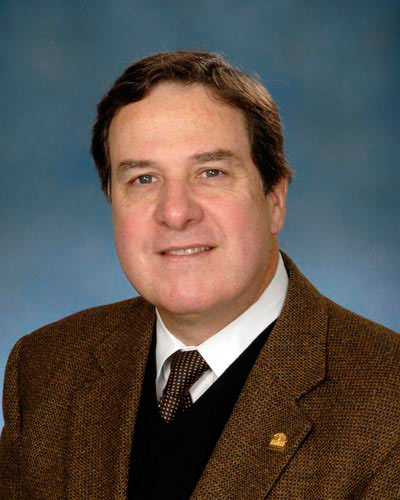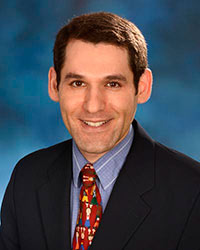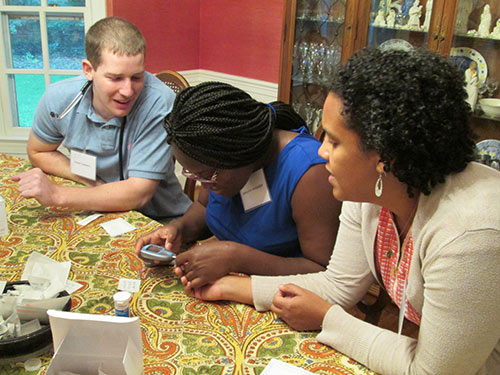May 10, 2018 | David Kohn

Program to Encourage Students to Pursue Primary Care Continues to Grow
This country faces a serious shortage of primary care doctors; the Association of American Medical Colleges estimates that by 2020, the U.S. will have a shortfall of 45,000 primary care physicians. Five years ago, to address this issue, the Departments of Family and Community Medicine, Internal Medicine and Pediatrics at the University of Maryland School of Medicine (UMSOM) have started the Primary Care Track (PCT), an innovative program that encourages medical students to become primary care doctors.
 To celebrate the success of the program, these departments are holding a celebration in Leadership Hall on May 11 from noon to 5 PM. The keynote speaker will be Robert L. Phillips, Jr., MD, MSPH, vice president of research and policy at the American Board of Family Medicine, where he works to enhance the research base that underpins much of primary care health policy. Dr. Phillips is a nationally recognized leader in primary care policy and health care reform. Following this, there will be a workshop on primary care, a poster session featuring primary care research at UMSOM, and a light reception. This year, the event will expand to be a collaboration with Johns Hopkins Medicine’s Primary Care Consortium.
To celebrate the success of the program, these departments are holding a celebration in Leadership Hall on May 11 from noon to 5 PM. The keynote speaker will be Robert L. Phillips, Jr., MD, MSPH, vice president of research and policy at the American Board of Family Medicine, where he works to enhance the research base that underpins much of primary care health policy. Dr. Phillips is a nationally recognized leader in primary care policy and health care reform. Following this, there will be a workshop on primary care, a poster session featuring primary care research at UMSOM, and a light reception. This year, the event will expand to be a collaboration with Johns Hopkins Medicine’s Primary Care Consortium.
 PCT is led by Richard Colgan, MD, a professor in the Department of Family and Community Medicine, along with Drs. Adam Spanier, associate professors in the Department of Pediatrics, Nikkita Southall, MD, an assistant professor in the Department of Internal Medicine as well as lead physician for education in the Baltimore VA Primary Care Clinic.
PCT is led by Richard Colgan, MD, a professor in the Department of Family and Community Medicine, along with Drs. Adam Spanier, associate professors in the Department of Pediatrics, Nikkita Southall, MD, an assistant professor in the Department of Internal Medicine as well as lead physician for education in the Baltimore VA Primary Care Clinic.
“When we started this program we had no idea it would become so successful,” said Dr. Colgan, who co-founded the program. “When given the opportunity, our students have been really eager to explore primary care.”
While UMSOM has focused on research, clinical care remains deeply important. Between a quarter and a third of the approximately 600 students at UMSOM have taken part in the PCT. In addition, in the two years, 70 percent of graduating PCT students chose to pursue a primary care residency.
“Reflecting on my experience at UMSOM, the Primary Care Track was the most valuable experience in my medical education,” says Richard Edgar who will be attending family medicine residency at the University of Pennsylvania next year. “PCT provides students with more patient interactions so that they can hone their history taking and physical examination skills. It allowed me to explore primary care in a variety of settings ranging from rural underserved practices in Princess Anne County to more urban practices here in Baltimore through its curriculum. The mentorship I received throughout my time in PCT helped shape the young physician I am today. Without a doubt, my experiences in PCT are a large reason why I will be pursuing career in Family Medicine.”
 Students in the program participate in monthly grand rounds addressing issues relevant to primary care, with an emphasis on care for the underserved in Maryland. In the first two years, students spend a half-day per month with one of 50 on-campus or 61 off-campus primary care faculty members coordinated by one of three Maryland Area Health Education Centers in Western Maryland, the Eastern Shore or Baltimore City. In their first summer, students work 80 hours with a doctor in one of several underserved areas in the state.
Students in the program participate in monthly grand rounds addressing issues relevant to primary care, with an emphasis on care for the underserved in Maryland. In the first two years, students spend a half-day per month with one of 50 on-campus or 61 off-campus primary care faculty members coordinated by one of three Maryland Area Health Education Centers in Western Maryland, the Eastern Shore or Baltimore City. In their first summer, students work 80 hours with a doctor in one of several underserved areas in the state.
About the University of Maryland School of Medicine
Commemorating its 210th Anniversary, the University of Maryland School of Medicine was chartered in 1807 as the first public medical school in the United States. It continues today as one of the fastest growing, top-tier biomedical research enterprises in the world -- with 43 academic departments, centers, institutes, and programs; and a faculty of more than 3,000 physicians, scientists, and allied health professionals, including members of the National Academy of Medicine and the National Academy of Sciences, and a distinguished recipient of the Albert E. Lasker Award in Medical Research. With an operating budget of more than $1 billion, the School of Medicine works closely in partnership with the University of Maryland Medical Center and Medical System to provide research-intensive, academic and clinically-based care for more than 1.2 million patients each year. The School has over 2,500 students, residents, and fellows, and nearly $450 million in extramural funding, with most of its academic departments highly ranked among all medical schools in the nation in research funding. As one of the seven professional schools that make up the University of Maryland Baltimore campus, the School of Medicine has a total workforce of nearly 7,000 individuals. The combined School and Medical System (“University of Maryland Medicine”) has an annual budget of nearly $6 billion and an economic impact in excess of $15 billion on the state and local community. The School of Medicine faculty, which ranks as the 8th-highest public medical school in research productivity, is an innovator in translational medicine, with 600 active patents and 24 start-up companies. The School works locally, nationally, and globally, with research and treatment facilities in 36 countries around the world. Visit medschool.umaryland.edu/
Contact
Office of Public Affairs
655 West Baltimore Street
Bressler Research Building 14-002
Baltimore, Maryland 21201-1559
Contact Media Relations
(410) 706-5260
